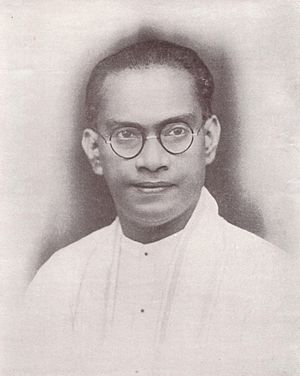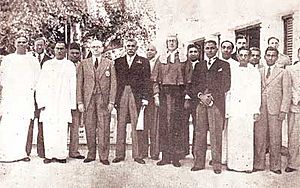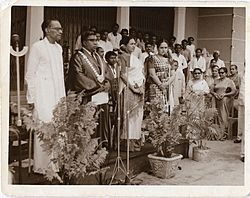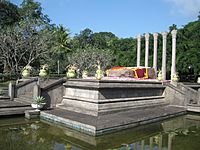S. W. R. D. Bandaranaike facts for kids
Quick facts for kids
S. W. R. D. Bandaranaike
|
|
|---|---|
| සොලොමන් වෙස්ට් රිජ්වේ ඩයස් බණ්ඩාරනායක சாலமன் வெஸ்ட் ரிட்ஜ்வே ඩයස් பண்டாரநாயக்கா |
|
 |
|
| 4th Prime Minister of Ceylon | |
| In office 12 April 1956 – 26 September 1959 |
|
| Monarch | Elizabeth II |
| Governor General | Oliver Ernest Goonetilleke |
| Preceded by | John Kotelawala |
| Succeeded by | Wijeyananda Dahanayake |
| 2nd Leader of the Opposition | |
| In office 9 June 1952 – 18 February 1956 |
|
| Prime Minister | Dudley Senanayake |
| Preceded by | N. M. Perera |
| Succeeded by | N. M. Perera |
| Leader of the Sri Lanka Freedom Party | |
| In office 2 September 1951 – 26 September 1959 |
|
| Preceded by | Position established |
| Succeeded by | C. P. de Silva |
| Leader of the House | |
| In office 26 September 1947 – 12 July 1951 |
|
| Prime Minister | D. S. Senanayake |
| Preceded by | D. S. Senanayake |
| Succeeded by | John Kotelawala |
| Minister of Health and Local Government | |
| In office 26 September 1947 – 12 July 1951 |
|
| Prime Minister | D. S. Senanayake |
| Preceded by | Position established |
| Succeeded by | Dudley Senanayake |
| Member of the Ceylon Parliament for Attanagalla |
|
| In office 14 October 1947 – 26 September 1959 |
|
| Preceded by | Constituency established |
| Succeeded by | James Obeyesekere |
| Personal details | |
| Born | 8 January 1899 Colombo, Ceylon (now Sri Lanka) |
| Died | 26 September 1959 (aged 60) Colombo, Ceylon (now Sri Lanka) |
| Political party | United National Party (1946–1951) Sri Lanka Freedom Party (1951–1959) |
| Spouse | Sirima Ratwatte (m. 1940) |
| Children | Sunethra Chandrika Anura |
| Parent | Solomon Dias Bandaranaike (father) |
| Relatives | Panini Ilangakoon (cousin) James Peter Obeyesekere II (cousin) |
| Education | Christ Church, Oxford (BA) Inner Temple (LPC) |
Solomon West Ridgeway Dias Bandaranaike (born January 8, 1899 – died September 26, 1959), often called S. W. R. D. Bandaranaike, was an important political leader in Ceylon (now Sri Lanka). He served as the fourth Prime Minister of Ceylon from 1956 until 1959.
Bandaranaike founded the Sri Lanka Freedom Party, a political party that focused on left-wing ideas and Sinhalese nationalist goals. During his time as Prime Minister, he brought in some of the first major changes to the country. These changes aimed to help ordinary people and promote local culture.
He came from a rich and powerful family. He studied at Christ Church, Oxford in England and became a lawyer. After returning to Ceylon, he joined politics and worked his way up. His leadership led to big changes in Ceylon's language policy and its relationships with other countries. Sadly, he was shot in 1959 and passed away the next day.
Contents
- Early Life and Education
- Starting a Political Career
- Serving in the State Council
- Forming the Sinhala Maha Sabha
- First Cabinet Minister and Leader of the House
- Starting the Sri Lanka Freedom Party
- Becoming Leader of the Opposition
- Prime Minister of Ceylon
- Assassination
- Family Life
- Legacy
- Electoral History
- See also
Early Life and Education
Bandaranaike was born in Colombo, Ceylon. His family, the Bandaranaike family, was very wealthy and influential. His father, Sir Solomon Dias Bandaranaike, was a high-ranking official in Ceylon. His mother, Daisy Ezline Obeyesekere, also came from an important family.
He was taught at home by English tutors. Later, he went to St Thomas' College in Ceylon. He was a good student and enjoyed debating. He then went to Christ Church, Oxford University in England. There, he studied philosophy, politics, and economics. He was a skilled debater and was elected junior treasurer of the Oxford Union. In 1924, he became a lawyer.
Starting a Political Career
After finishing his studies in Britain, Bandaranaike returned to Ceylon. He quickly became active in local politics. He was elected as the Chairman of the Nittambuwa Village Committee. In 1926, he became the Secretary of the Ceylon National Congress, a major political group. He was also elected to the Colombo Municipal Council.
Serving in the State Council
When the State Council of Ceylon was created, allowing people to vote, Bandaranaike was elected without opposition from Veyangoda in 1931. He served on the committee for local administration.
In 1936, he was re-elected from Veyangoda. He then became the Minister of Local Administration. This role made him responsible for local government matters across the country.
Forming the Sinhala Maha Sabha
In 1936, Bandaranaike started a group called the Sinhala Maha Sabha. This group aimed to promote Sinhalese culture and protect the interests of the Sinhalese community. He believed in self-rule for Ceylon.
In 1947, he joined forces with D. S. Senanayake, another important leader. They merged the Sinhala Maha Sabha with other groups to form the United National Party (UNP). This new party aimed to lead Ceylon towards independence.
First Cabinet Minister and Leader of the House
In the 1947 election, Bandaranaike won a seat in the new House of Representatives. He represented Attanagalla, which became his family's political home for many years.
In September 1947, D. S. Senanayake became the first Prime Minister of independent Ceylon. He appointed Bandaranaike as the first Minister of Health and Local Government. Bandaranaike was also chosen as the Leader of the House. This made him a very senior member of the government. He played a key role in Ceylon gaining independence from Britain on February 4, 1948.
As Minister of Health, he worked to improve healthcare and expand hospitals. However, he started to disagree with Prime Minister Senanayake on some policies.
Starting the Sri Lanka Freedom Party
In July 1951, Bandaranaike decided to leave the government. He also left the United National Party. He then formed a new political party called the Sri Lanka Freedom Party (SLFP). The first meeting of this new party was held on September 2, 1951.
A few months later, Prime Minister D. S. Senanayake passed away. His son, Dudley Senanayake, became the new Prime Minister. A general election was held in 1952.
Becoming Leader of the Opposition
In the 1952 election, Bandaranaike was re-elected to his seat. His new party, the SLFP, won nine seats. With this, Bandaranaike became the Leader of the Opposition. This meant he was the main voice against the government in Parliament.
The Five Great Forces
Between 1952 and 1956, Bandaranaike worked hard to build up his new party. He focused on getting support from people in rural areas who felt ignored by the government.
He introduced the idea of the 'Pancha Maha Balavegaya' (Five Great Forces). These forces were:
- Native doctors
- Clergy (religious leaders, especially Buddhist monks)
- Teachers
- Farmers
- Workers
He believed these groups were the backbone of the country and should have a stronger voice. The SLFP also became a strong supporter of the Buddhist religion and the use of Sinhala as the main language.
Winning the 1956 Election
In 1956, another election was called. Bandaranaike formed a powerful group called the Mahajana Eksath Peramuna (MEP). This group included his party and some smaller parties. They campaigned on ideas of Sinhalese nationalism and helping ordinary people.
Even though he didn't have a lot of money for his campaign, Bandaranaike managed to win a huge victory. The MEP gained a two-thirds majority in Parliament.
Prime Minister of Ceylon
In April 1956, Bandaranaike became the fourth Prime Minister of Ceylon. He formed his cabinet with members from the MEP coalition.
Language Policy and Social Changes
One of his main promises was to make Sinhala the only official language. He passed the Official Language Act in 1956. This law replaced English as the official language.
This change had a big impact. It caused problems and protests among the Sri Lankan Tamils, who felt left out. These protests sometimes led to riots. To try and fix this, the Tamil Language (Special Provisions) Act was passed in 1958, but it didn't make Tamil an official language like Sinhala.
He also introduced laws to stop discrimination based on caste.
Foreign Policy Shifts
Bandaranaike changed Ceylon's foreign policy significantly. He started building relationships with countries like China and the Soviet Union. He also moved Ceylon towards the Non-Aligned Movement, meaning Ceylon would not take sides in the Cold War between major world powers.
He asked Britain to remove its military bases from Ceylon. This meant Ceylon became more independent in its defense.
Economic Changes
Bandaranaike brought in many socialist reforms. This meant the government took control of some businesses and services. For example, he nationalized (took over) bus companies and formed the Ceylon Transport Board. He also nationalized the Colombo Harbour and created the Ceylon Shipping Corporation.
He also introduced the Paddy Lands Bill to help farmers and established the Employees' Provident Fund to help workers save money for retirement. May day was declared a public holiday.
Assassination
Bandaranaike's time as Prime Minister ended suddenly. On September 25, 1959, he was shot at his home in Colombo. He passed away the next day, on September 26, 1959, at the age of 60.
After his death, Wijeyananda Dahanayake, who was the Minister of Education, became the caretaker Prime Minister. However, the government faced a lot of problems.
Eventually, Bandaranaike's wife, Sirima Ratwatte Dias Bandaranaike, took over the leadership of the Sri Lanka Freedom Party. In July 1960, she led the party to victory in the elections. She became the world's first female Prime Minister. She continued many of her husband's policies during her time in office.
Family Life
In 1940, Bandaranaike married Sirima Ratwatte. Their wedding was a very big event. Their marriage connected his family, from the low-country, with an important family from the Kandyan region.
They had three children: Sunethra, Chandrika, and Anura. After his father passed away, Bandaranaike inherited the family home, Horagolla Walauwa. This area, Attanagalla, became the political base for his family for many years.
His wife, Sirima Ratwatte Dias Bandaranaike, became the world's first female Prime Minister. His daughter, Chandrika Kumaratunga, later became Prime Minister and then the first female President of Sri Lanka. His son, Anura Bandaranaike, also became a Speaker of Parliament and a Minister.
Legacy
S. W. R. D. Bandaranaike is seen as a very important figure in Sri Lankan history. He is remembered for bringing in major changes, especially his language policy. This policy aimed to promote Sinhala but also led to long-lasting tensions between different communities in the country.
Many things have been named in his honor. The Bandaranaike Memorial International Conference Hall was built in his memory by China in 1970. It also houses the S W R D Bandaranaike Museum. The main international airport in Sri Lanka, Bandaranaike International Airport, was also named after him.
Electoral History
| Election | Constituency | Party | Votes | Result | |
|---|---|---|---|---|---|
| 1931 state council | Veyangoda | Independent | Unopposed | Elected | |
| 1936 state council | Veyangoda | Independent | Unopposed | Elected | |
| 1947 parliamentary | Attanagalla | United National Party | 31,463 | Elected | |
| 1952 parliamentary | Attanagalla | Sri Lanka Freedom Party | 38,478 | Elected | |
| 1956 parliamentary | Attanagalla | Sri Lanka Freedom Party | 45,016 | Elected | |
See also
 In Spanish: Solomon Bandaranaike para niños
In Spanish: Solomon Bandaranaike para niños
- S. W. R. D. Bandaranaike cabinet
- Bandaranaike-Chelvanayakam Pact
- List of political families in Sri Lanka





